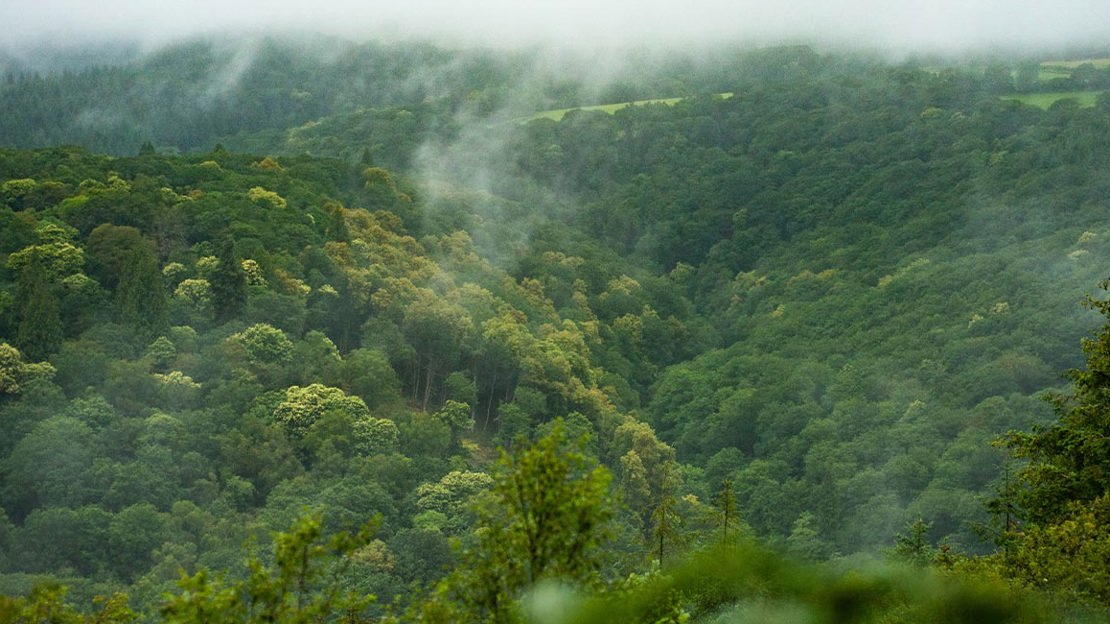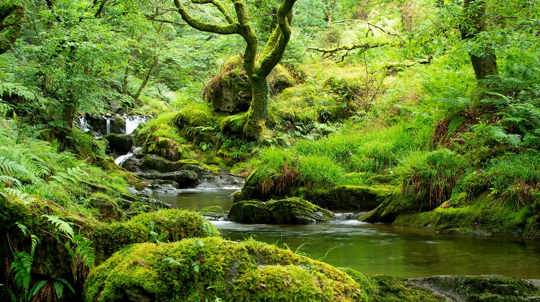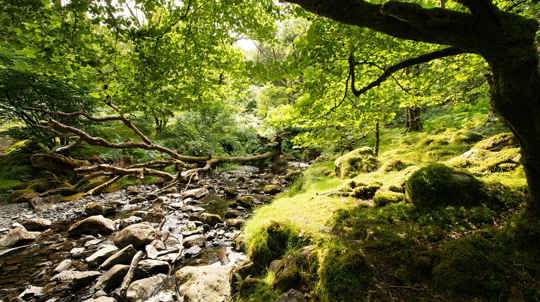Protecting and restoring temperate rainforest in Devon
See how we're working with organisations including Plantlife and the National Trust to protect and restore temperate rainforest sites across Devon.
Video length: 00:06:32
>> Dr Alison Smith, lead community scientist, Plantlife: Temperate rainforest is a globally rare and threatened habitat type, which is characterised by very high rainfall which is spread throughout the year, and a low variation in temperature, so wet conditions, very mild conditions. And that gives rise to one of the defining features which is this really luxuriant growth.
>> David Rickwood, site manager, the Woodland Trust: The Woodland Trust manages and owns a number of the most important temperate rainforest sites in Southwest England. We have a significant contribution to make to the protection of these sites.
We're in Ausewell wood, this site was purchased in partnership with the National Trust and we manage it together. Ausewell sits on the bank of the River Dart on the eastern side of Dartmoor. The River Dart is a deep, winding gorge. As a consequence it's very rocky, it's also very damp, and that provides great climate for this kind of niche temperate forest to exist.
>> Dan Johnson, head of environment, Oxygen Conservation: We're at the amazing 800-acre Leighon Estate which includes 120 acres of temperate rainforest. From day one we've been very fortunate to have met a range of fantastic conservation-focused organisations to include the Woodland trust and that's been instrumental in our understanding of the importance of this site.
>> Naomi Oakley, farmer and farm advisor: It's a wonderful mosaic of habitats. We've got the open moorland and then we've got this temperate rainforest down in the bottom. Beautiful old trees covered in lichens and scrub. We get temperate rainforest here because it's incredibly wet, and this combination of altitude, this shelter and this continual dampness and moistness all the time gives us the perfect conditions for temperate rainforest, and all of the wonderful things that you can find in the temperate rainforest like this incredible lichen.
>> Dr Alison: We're in the amazing Lydford Gorge, it's a temperate rainforest site owned by the National Trust. It's particularly important as a temperate rainforest site for its lichen interest, and also its bryophyte interest which is the mosses and liverworts. We've got a number of lichens – Peltigera canina, some Stictas and tree lungwort, which we find on our ash trees.
>> Demelza Hyde, area ranger, the National Trust: In terms of ash dieback, the impact on our woodland is continuing to be significant, so where we're felling the ash because they're dangerous, we want to continue to make sure that those lichens are protected and they can flourish.
>> Dr Alison: Lots of the species we have an international responsibility to conserve, it doesn't necessarily mean they're very very rare, but it means that the UK has a significant proportion of the global population so therefore it's something that we need to look after. This one that you can see with these beautiful reddish-brown fruits is Peltigera horizontalis, and then just up here we’ve got this sort of frilly one, which is one of the Sticta species, and then we've also got one of these bushy Usnea lichens.
So another species this site is important for is known as Hutchins’ hollywort, and this is a really beautiful green liverwort. It sort of forms these fan-like shelves in the splash zones of fast flowing rivers and waterfalls. It's a hyper-oceanic species so it's very much restricted to that temperate rainforest climatic zone.
>> David: These woodlands are really important for a whole range of other species assemblages. Woodland birds is a really key assemblage we try to manage the forest for. There's roughly about 40 to 44 breeding species of birds in the woodland here. Some of the key ones are migrants like pied flycatcher, species like wood warbler, another one would be lesser spotted woodpecker. So these are all quite rare and declining species nowadays.
Another amazing assemblage of species we have on our site like this is bats. There are 13 species of bats here out of 17 in the UK, and so just like rare and declining plants we need to think about how we manage the woods for them.
>> Dan: One of the biggest threats our temperate rainforests face is the abundance of invasive non-native species, and one of the issues that we have at the moment on our estate is historically introduced rhododendron. They're made up of very complex and heavy branch structures. That obviously shades out a lot of the lower trunks on our amazing trees in the rainforest.
>> David: So the key task that we face is actually trying to increase light levels, and we do that by felling and slowly removing invasive species. We annually use some local horse logging companies to help us with this work, and we make that efficient by utilising them where they’re best put to the task. Horses provide a kind of nimbleness and an agility to work on those difficult areas.
>> Dr Alison: There are obviously lots of challenges to managing a site like this, particularly with the steep and rocky terrain, lots of places are inaccessible.
>> Naomi: It's really important that we think about the long-term goals. We want to have some light grazing. Cattle are particularly fantastic because as they walk through and they graze they punch little holes in the grass, and that allows more sensitive species to get in and colonise.
>> Demelza: We have around 80,000 visitors a year. It presents us with a lot of challenges, particularly around our tree safety management and also rock faces, so they get inspected every year to make sure it's safe and allow people to continue to visit the gorge. So it's a fine balance between managing visitor access and also balancing that with the conservation interests of the woodland.
>> David: We need to look at the expansion of some of these sites into habitats that, actually, will be suitable for them in the long term, because some of these sites will start to decline just purely because of their geography.
>> Dan: My advice to existing and potential owners of temperate rainforest is to appreciate, you know, what you have in the first place, but talk to people, reach out to conservation-focused organisations, understand the value and significance of that and where it fits into the wider landscape. From that you can then develop the management plan, whether it's direct intervention straight away or just sustain natural intervention over time.
>> Naomi: That stability is what will be so important going forward for temperate rainforests for carbon capture, for climate change and for future generations so that they can enjoy this amazing habitat.






